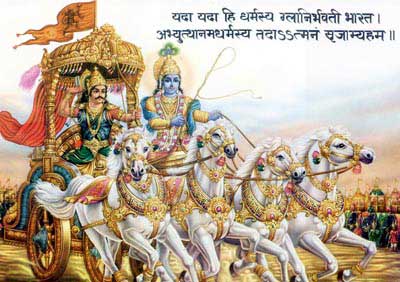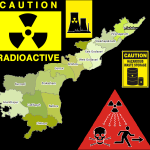The following post is published courtesy of Krishnarjun garu, who kindly gave permission to reprint a version of his informative piece on Dharmanomics.
India is at a cross roads. There is rising debate and discussion on development. There is lot of talk and hype about aspirations and the virtues of Entrepreneurship. In the last two decades the global exposure of average Indian increased, people are getting increasingly impatient about the state of affairs in India vis-a-vis other countries, particularly the West. The neo-enlightened, globe-trotting Indians are fascinated by the glitz of modern economies, particularly of Western variety. They strongly believe India should follow them. Some more enlightened among them armed with their Ivy League degrees tend to sermonize their lesser economically enlightened countrymen on the virtues of Capitalism, free markets, Economic right philosophies, and Libertarianism. Some, like this writer, disagree with this standard rhetoric, mostly borrowed from the West, put forth by neo-economically enlightened class as panacea for India’s poverty.
Most of these neo-enlightened are sincere; they want India to prosper and end the misery of impoverished millions. But they are borrowing models that already failed. Capitalism as practiced in the so called advanced economies is in crisis. The model dislikes interference of any other institution between state, corporation and citizen. Though the standard of life is made high with borrowed prosperity, insecurity is all pervasive. The giant corporation is omnipotent and omnipresent with limited space left for self-employment. The farm, the city, the house, the work space is directly or indirectly at the mercy of corporation.
In the last few years, glaring holes surfaced in the corporate capitalist model that could no longer be hidden. The lifeline of this model is material innovation to create new markets for business and growth. The model managed to flourish for little over a century with new product innovation. It began with mechanical gadgets followed by the revolution in electrical & electronics engineering. Currently, the pace of innovation is coming down and is limited by current knowledge. It seems humanity has not progressed much in core physical knowledge for over half a century and any further progress is unlikely to create big markets. The unlimited product innovation and market creation to satisfy the perennial hunger of the corporation is no longer guaranteed. So, the big corporation has turned its eye on appropriating nature, its flora and fauna. Nature has created and evolved the most inert elements for life to flourish and progress. The big corporation wants to muddle the equilibrium to appropriate in the name of intellectual property rights. They can’t bear to see anything on planet as a free gift of nature to life. They are addicted to measuring everything with money.
This is the brief summary of the capitalistic model that enamours neo-enlightened India. Then how can India prosper? Shouldn’t India rise to world standards? India has to prosper and can prosper without compromising its existing priceless institutions like family, community and its age-old dharma. It has to evolve a system from the roots of Dharma and natural justice. The model is not new, India lived with real prosperity for millennia following the natural justice of Dharma. It worshipped all the elements of its prosperity from rivers and mountains to flora and fauna. The secret of its perennial prosperity was its love for the divine nature. The Indic civilization begged Mother Nature for milk and never tried to draw blood. Its innovation was to facilitate and nourish life, it was more concerned about how to innovate and cause more rain for life than manufacturing Intercontinental ballistic missiles.
How to adopt this model of Dharma to the present scenario? Does Dharmanomics means going back into time and shunning modernity? The answer is no. Many enthusiasts of the neo-economic right in India try to project any alternative to their borrowed economic models as statist and regressive. Dharmanomics is about blending natural economy, natural justice to the modern situation.
India can’t live in an isolated economic and cultural existence from the rest of the world. It has to engage contemporary world on its own terms. For that it needs to be on par with rest of the world in technology and military strength. Military strength is linked with best technology and high end manufacturing. Research and innovation in these areas have to be encouraged. If private and foreign investment can best help such innovation it should be facilitated. High end manufacturing clusters can be established on waste lands along the coast. Over time few of these clusters could emerge into mega cities.
But can these urban manufacturing centers be allowed to dominate whole economy? If India is successful in high-tech manufacturing, will that ensure prosperity? Real prosperity means good food, clean water and air, a comfortable home, a profession, good health, good family, and social life. If the land gives enough food, then the rest can be achieved with proper organization of the society. Food economy is the root of prosperity. In other words balancing food economy and high-end manufacturing is critical for prosperity and to defend that prosperity from external threats.
India’s food economy and manufacturing should complement each other. City-states can be centers of modern manufacturing and economic organization while decentralized Panchayat structure could support life with all its diversity. The city capitalist or corporation shouldn’t be allowed to monopolize the food and rural economy. The farmland shouldn’t become an instrument of investment for profit. Only professional farmer have to be allowed ownership of farmland and the community. The Panchayat has to certify him as farmer. This gives an incentive and dignity to farming as a profession, as a consequence the rural life would boom around him with addition of small manufacturing and services. This model would optimize employment generation.
The farm economy has to be self-organized to optimize food production and allowed to fix its own prices to their produce. Farming can be taxed like any other profession. This kind of restriction on farm land ownership by non-farmers is there in Gujarat and it is also the best state where rural economy is self-organized.
Modern India needs its own plan for prosperity. Borrowed models can’t fit its numbers, geography, social and spiritual temperament. Fortunately, India’s population is so huge that it can support diverse economic models. The traditional system can co-exist in harmony with modern organization without one preying on other. Harmony of self and environment is the essence of Dharma and to see the possibility of such harmony in the economy is Dharmanomics.
A version of this Article was Published on Vijayvaani. The full article can also be found here on his personal blog. You can also follow Krishnarjun gaaru on Twitter.






